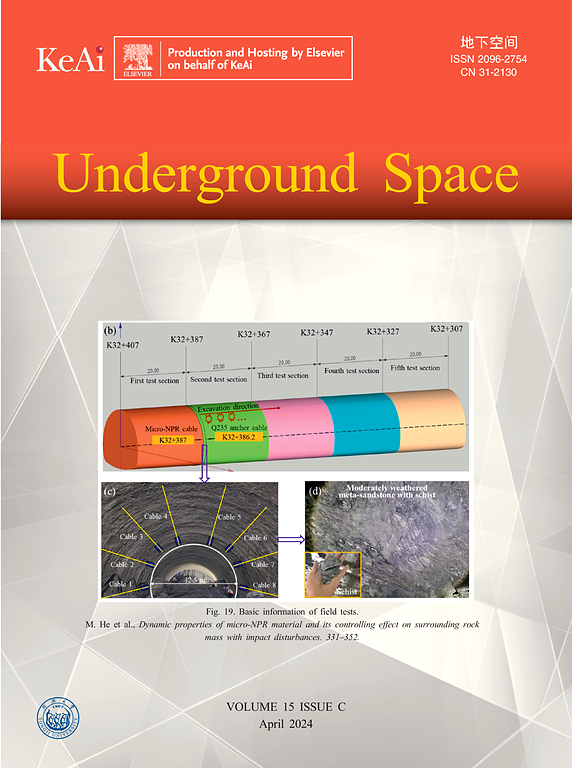高内部气体压力下断裂网络对衬砌岩洞结构变形的影响
IF 8.3
1区 工程技术
Q1 ENGINEERING, CIVIL
引用次数: 0
摘要
在本文中,我们基于有限元法建立了一个二维(2D)数值模型,用于分析断裂网络对加压内衬岩洞(LRCs)行为的影响。我们使用离散断裂网络方法来表示岩石中服从幂律长度分布的断裂系统。由内层钢衬里和外层钢筋混凝土组成的 LRC 位于岩体中,岩体的特征是空间分布的交错断裂。采用弹性脆性构造关系来描述完整岩石的变形/破坏,而经典的马扎斯破坏模型则用于模拟混凝土衬里的开裂。对于岩石中已存在的裂缝,则采用非线性应力-位移公式来捕捉其法线和剪切变形。二维模型代表了 LRC 及其周围岩体的水平横截面,受到规定的原位应力条件的影响。我们探索了与不同幂律长度指数值和断裂强度相关的各种断裂网络方案。我们分析了岩石/混凝土中的损伤演变以及混凝土/钢衬里中的切向应变。结果发现,岩体内部的破坏主要以翼状裂缝的形式演变,这些裂缝从预先存在的裂缝尖端处延伸出来。至于混凝土衬里的破坏发展,主要是在岩洞加压的情况下由拉伸裂缝引起的。损伤出现在衬砌部分,在这些部分,原有裂缝位于岩洞周围的拉伸区域,要么与岩洞壁相交,要么通过促进翼状裂缝扩展而到达岩洞壁。我们的研究结果和见解对用于可持续储氢的 LRC 的设计优化和性能评估具有重要意义。本文章由计算机程序翻译,如有差异,请以英文原文为准。
Impact of fracture networks on the structural deformation of lined rock caverns under high internal gas pressure
In this paper, we develop a two-dimensional (2D) numerical model based on the finite element method to analyse the impact of fracture networks on the behaviour of pressurised lined rock caverns (LRCs). We use the discrete fracture network approach to represent the fracture system in rock obeying a power law length distribution. The LRC consisting of an inner steel lining and an outer reinforced concrete is situated within the rock mass characterised by spatially distributed and intersected fractures. An elasto-brittle constitutive relationship is adopted to characterise the deformation/failure of intact rocks, while the classical Mazars damage model is used to simulate the cracking of concrete linings. For pre-existing fractures in rock, a non-linear stress-displacement formulation is implemented to capture their normal and shear deformations. The 2D model, representing the horizontal cross-section of an LRC with its surrounding rock mass, is subject to a prescribed in situ stress condition. We explore various fracture network scenarios associated with different values of power law length exponent and fracture intensity. We analyse the damage evolution in rock/concrete and tangential strain in the concrete/steel linings. It is found that the damage within the rock mass mainly evolves in the form of wing cracks that emanate from the tips of pre-existing fractures. For damage development in the concrete lining, it is primarily induced by tensile cracking under cavern pressurisation. The damage emerges in the lining sections where pre-existing fractures are located in the tensile region around the cavern and either intersect with the cavern wall or could reach the cavern wall by promoting wing crack propagation. The results and insights obtained from our study have significant implications for the design optimisation and performance assessment of LRCs for sustainable hydrogen storage.
求助全文
通过发布文献求助,成功后即可免费获取论文全文。
去求助
来源期刊

Underground Space
ENGINEERING, CIVIL-
CiteScore
10.20
自引率
14.10%
发文量
71
审稿时长
63 days
期刊介绍:
Underground Space is an open access international journal without article processing charges (APC) committed to serving as a scientific forum for researchers and practitioners in the field of underground engineering. The journal welcomes manuscripts that deal with original theories, methods, technologies, and important applications throughout the life-cycle of underground projects, including planning, design, operation and maintenance, disaster prevention, and demolition. The journal is particularly interested in manuscripts related to the latest development of smart underground engineering from the perspectives of resilience, resources saving, environmental friendliness, humanity, and artificial intelligence. The manuscripts are expected to have significant innovation and potential impact in the field of underground engineering, and should have clear association with or application in underground projects.
 求助内容:
求助内容: 应助结果提醒方式:
应助结果提醒方式:


